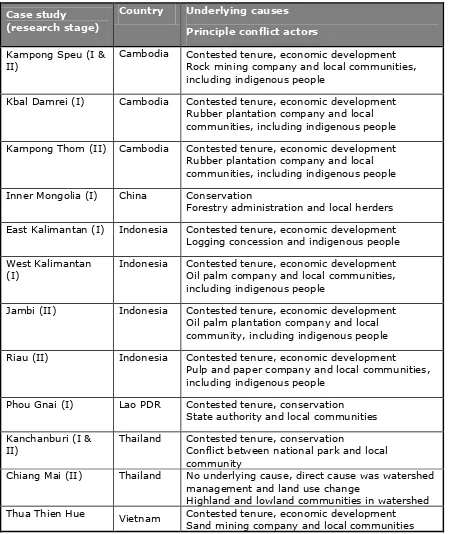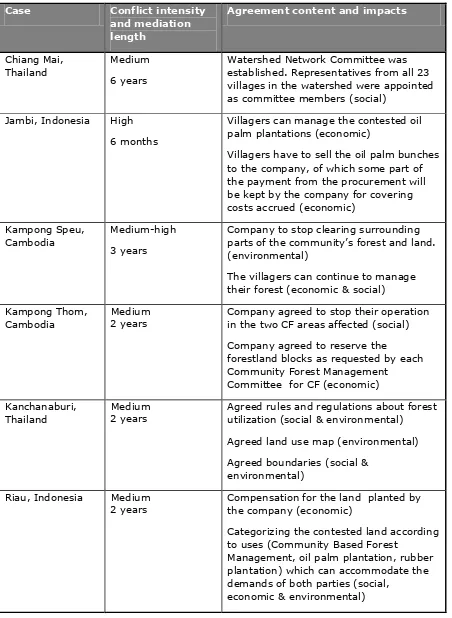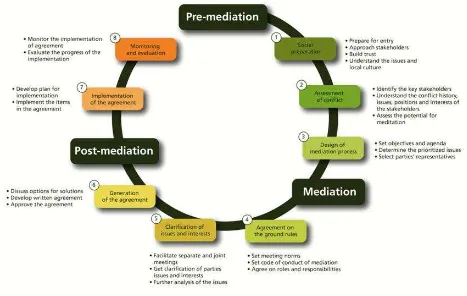XIV
WORLD
FORESTRY
CONGRESS,
Durban, South Africa, 7-11 September 2015
Transforming Forest Conflicts in Asia-Pacific: A Capacity
Development Approach
Seth Kane1, David Gritten2, Lok Mani Sapkota3, Linh, Thi Bui4, Ahmad Dhiaulhaq5
1
RECOFTC – The Center for People and Forests, Thailand. [email protected]
2 RECOFTC – The Center for People and Forests, Thailand, [email protected] 3
RECOFTC – The Center for People and Forests, Thailand. [email protected]
4
RECOFTC – The Center for People and Forests, Thailand. [email protected]
5
RECOFTC – The Center for People and Forests, Thailand, [email protected]
Abstract
Asia-Pacific is a forest conflict hotspot as too often forest governance and management excludes the interests and values of local and indigenous people, who see their rights increasingly diminished as the allocation of forestland to private sector entities and conservation areas intensifies.
The abundance of forest conflicts underlines the need to address them in a sustainable manner - i.e. conflict transformation, where conflict is seen as an opportunity to seek lasting positive changes at the relational level between key actors, but also at the structural, institutional and societal levels. RECOFTC - The Center for People and Forests is working to reduce the incidence and negative impacts of natural resource conflict and to tackle the root causes of conflict. Our principal strategy is to strengthen the capacity of relevant institutions and key stakeholders at all levels to transform conflict in positive ways. As part of this we have conducted and published research to understand the role and potential of mediation to transform forest conflicts by examining best practices in the Asia-Pacific region.
As part of RECOFTC’s capacity development program we, together with partners, are using the
findings of the research in our strategic communication to raise awareness of mediation as a tool for transforming forest conflict, and in our training programs through development of, for example, an
advanced conflict mediation manual. The program’s success is greatly dependent on partnership
between governmental and non-governmental organizations, the private sector, and rural communities.
In the above context the aims of the paper are threefold: 1. Increase understanding of conflict transformation
2. Highlight the value of mediation in conflict transformation
3. Build and strengthen the capacity of a network of conflict transformation practitioners from governments, NGOs, private sector and community organizations.
Introduction, scope and main objectives
Asia-Pacific is a forest conflict hotspot (Yudego and Gritten 2010; Gritten et al. 2013). These conflicts are often played out between local actors (communities and indigenous peoples) and outsiders such as government agencies and private companies. Competition of more people trying to use limited natural resources, rapid socio-political changes, decentralization, and expanding markets for land and forest products have heightened tension and intensified conflicting needs and priorities for resources (de Koning et al. 2008).
Conflict is a situation where an actor feels impaired or restricted by the behavior of another actor having different perceptions, emotions, goals, values, or interests (Lewicki et al. 2003). A prime cause of forest conflicts can be attributed to changes in access to forests, enabled by overlaps between statutory and customary claims, ambiguous property rights, lack of coordination among government agencies and conservation and economic development policies that prioritize global and national interests over local interests, needs, and aspirations (Gritten 2009).
Conflict impacts can be both positive and negative. Where conflict is managed appropriately, positive outcomes can emerge such as reaching agreements and improved resource management via better collaboration (Yasmi et al. 2009). On the other hand, if poorly addressed, negative impacts may dominate (Gritten et al. 2009). Anxiety and fear, disharmony and division among social groups, distrust, high costs and environmental degradation are the major negative impacts of the conflict (Gritten 2009, Patel et al. 2012). Forest conflicts are found to accelerate deforestation, worsen social relations and increase social risks (Hares 2009). Resource conflicts can sometimes become severe and debilitating, resulting in violence, resource degradation, the undermining of livelihoods, and the uprooting of communities. Conflicts also increase financial risks for companies involved (Munden Project 2012).
On the positive side conflict is found to enhance collective action in the community affected, increase awareness of the conflict issue and often lead to pressure for clarifying tenure (Castro and Nielsen 2001, Hares 2009). Additionally, in some cases conflicts provide local people with the opportunity to participate in forest management and they allow negotiation and stimulate learning (Castro and Nielsen 2001). Therefore, conflicts can be constructive as they can be useful in understanding the competing needs for resources, and developing appropriate transformative and sustainable measure to respond to these needs.
In the above context the aim of the paper is to examine tools to maximize the positive outcomes from forest conflicts, in other words forest conflict transformation. The paper will particularly focus on mediation. The geographical focus of the paper will be Asia-Pacific. The paper will provide recommendations for how mediation and other conflict transformation approaches can be scaled-up and mainstreamed in the region.
Methodology/approach
Table 1: Description of the forest conflicts covered in the research (see Yasmi et al. 2010 and
Dhiaulhaq et al. 2015 for more information)
Case study
Kbal Damrei (I) Cambodia Contested tenure, economic development
Rubber plantation company and local communities, including indigenous people
Kampong Thom (II) Cambodia Contested tenure, economic development
Rubber plantation company and local communities, including indigenous people
Inner Mongolia (I) China Conservation
Forestry administration and local herders
East Kalimantan (I) Indonesia Contested tenure, economic development
Logging concession and indigenous people
Pulp and paper company and local communities, including indigenous people
Phou Gnai (I) Lao PDR Contested tenure, conservation
State authority and local communities
Chiang Mai (II) Thailand No underlying cause, direct cause was watershed
management and land use change
maximizing participation of people in decisions affecting their lives (procedural justice) (Lederach 1997). In other words, approaches to address conflict should be geared towards transformation.
There are often differences of opinion about what are the indicators that a conflict has been transformed. Augsberger (1992) focuses on changes in attitudes (including viewing each other in a spirit of goodwill and mutual respect) and behavior (focusing on collaborative behavior including attempting to remove incompatibilities to pursue mutual gains). Lederach (1997) takes this further; not only emphasizing changes at the personal and relational level but also at the structural, institutional and societal level, implying increased impact beyond the conflict site. Lederach (1997) envisions a problem as an opportunity for addressing the symptoms and engagement of systems which relationship are embedded.
Conflict transformation includes all aspects of the conflict tool set: prevention, management, resolution and post-conflict. In other words, transformation does not imply a specific activity or tool but indicates a general approach and set of values that can be applied at any stage of the conflict cycle and to any type of conflict. For example, in the forestry context, initiatives to mainstream and normalize a practice such as Free Prior and Informed Consent (FPIC) can be categorized as a transformative conflict prevention activity as FPIC transforms the usual power dynamics, relationships and attitudes that often determine land use and investment outcomes, and when implemented properly, prevents or greatly reduce the incidence of conflict.
Results
Contested tenure and overlapping claims over the forests and land were prominent underlying causes in many of the 12 conflicts studied (Table 1); this was often exacerbated by a lack of coordination among the state agencies. The contested tenure issue reflects the fact that the State throughout much of the region retains ownership of the land. Increased demand for food, and increased commodity prices have led governments to support agricultural expansion, including handing over land claimed by local communities as concessions to companies.
One of the findings from the first stage of the research was that, where applied, mediation appeared to be an effective approach for addressing the conflict. One of the conclusions was that, recognizing this potential, research should be conducted that specifically focuses on the use of mediation as a transformative approach to address conflicts. This was the basis for the second stage of the research, and the main focus of the research.
In the second research stage, it was found that mediation was not the first approach employed by the parties for addressing the conflicts. In some of the cases, the conflict parties tended to avoid confrontation early in the conflict. Once the conflict persisted, direct communications and negotiation by the parties were attempted but failed to produce agreements. As a result, mediation by third parties was chosen by the conflicting parties. In all cases the conflict parties entered mediation voluntarily. Four of the cases were mediated by non-governmental organizations (NGOs), while the Cambodian cases were mediated by a government office (Provincial Division of Forestry Administration). This somewhat contravenes the norm that mediators must be neutral-third parties.
Table 2: The agreement reached in study case study sites in stage II of the research (see Dhiaulhaq
et al. 2015 for more information). Medium intensity conflict is indicated by the infringement and/or restriction of one party’s activities by another, while the presence of violence indicates high
intensity conflict.
Villagers have to sell the oil palm bunches to the company, of which some part of the payment from the procurement will be kept by the company for covering costs accrued (economic)
parts of the community’s forest and land.
(environmental)
The research suggests that mediation works well in varying types of forest and land conflicts, and of mixed intensity. Numerous features have contributed to the success of the mediation. The research shows that the participatory nature of the mediation process was seen to be a key. This participatory process facilitated the development of a sense of belonging, trust, and ensured inclusive solutions that were acceptable to the conflict parties. This participatory process can be seen in the way the mediation process followed in all cases (Figure 1). The process followed facilitated transformation as it created a more equal environment at the mediation table, that was somewhat reflected in the outcomes.
Fig. 1: Mediation process followed in the conflict sites (Dhiaulhaq et al. 2014)
The agreements in the six cases were possible partly because the mediators had the skills needed (e.g.
facilitation) and worked as a team. The team aspect was felt to be important due to the conflicts’ complexity. The skills and knowledge were acquired either from the mediators’ previous work or
through training. The mediators’ confidence and strategies they employed drew on previous experience, while training on conflict management provided them with the analytical, planning, communication and management skills required, giving them skills to facilitate the mediation process in a systematic and effective manner.
Discussion
While Augsberger’s (1992) criteria for transformation were largely satisfied, Lederach’s (1997)
will require long term engagement and trust building with governments in collaboration with NGOs at the sub-national and national levels.
The sustainability of the transformative impact of mediation is at risk where institutions for conflict transformation are not in place or existing institutions are not strong enough (i.e. do not have the capacity) to implement or monitor agreements. In this regard, this study suggests strengthening of governance and institutions to transform conflict, and to mainstream mediation approaches in multi-stakeholder natural resource management contexts. It can also be achieved by, for example, strengthening (or even creating) credible and impartial platforms responsible for addressing grievances and transforming conflict at local and national levels.
In regards to the amount of time spent addressing the six mediation cases which ranged from 6 months to 6 years, this reflects at least two things: firstly, the fact that mediation can take a long time given that it is inherently difficult and complex requiring, for example, coordination with different levels of government. Secondly, the length of mediation may also reflect the lack of effectiveness and efficiency in efforts to address conflict which may relate to the mediators’ capacity, some of whom were learning on the job.
There are, however, numerous challenges that must be addressed, including scaling up the transformative impact of the mediation from the local to the national level. This is based on the recognition that transformation will be severely limited if its impacts are confined to the conflict site and fails to address the underlying causes of the conflict that often emanate from national level developments, such as policies.
Conclusions/outlook
Overall recommendations for achieving conflict transformation through prevention and policy initiatives:
1. Accelerate reforms and clarify tenure arrangements that respect local resource management.
2. Employ FPIC with local residents regarding possible land-use changes that may affect them.
3. Ensure that communities benefit from land investment activities such as prioritizing employment opportunities for them.
4. Improve coordination between government agencies with overlapping mandates.
5. Integrate local livelihood strategies into conservation policy.
A comprehensive capacity development programmatic approach towards transforming forest conflict should include five mutually reinforcing and interwoven activities:
1. Continued participatory research focusing on gaining practical insights and producing actionable recommendations, includes in depth case studies to elucidate context specific mechanisms, as well as elucidating capacity gaps and influencing policymakers through accessible language and theoretical frameworks.
2. Creating new and strengthening existing capacity development training curriculum. These should be conceptualized by subject matter experts using the latest research and drafted in collaboration with specialists in adult participatory inter-cultural learning processes.
map. Wherever possible, trainings should be tailored to the specific conflict subject matter to be addressed such as conflicts related to REDD+ (Reducing emissions from deforestation and forest degradation).
4. Regional and national learning networks that include field visits, learning groups, and research collaboration among other activities is important to foster a sense of professionalism, support and ultimately a community of dedicated conflict transformation practitioners. Such a community can underpin and sustain a long-term strategy of capacity development, continuous learning, norm shifting and regional ownership of the processes and concepts being promoted.
Acknowledgements
The authors are grateful to the Swedish International Development Cooperation Agency (SIDA), the Norwegian Agency for Development Cooperation (NORAD) and the Swiss Agency for Development and Cooperation (SDC) for funding this research. The authors are also grateful to the various colleagues past and present at RECOFTC for their contribution to this work. The authors are also extremely grateful to those taking part in the research.
References
Augsberger DW. 1992. Conflict mediation across cultures: Pathways and patterns. Louisville, Kentucky: Westminster/John Knox Press, 1992.
Castro AP, Nielsen E. 2001. Indigenous people and co-management: Implications for conflict management. Environmental Science and Policy, 4: 229-239.
de Koning R, Capistrano D, Yasmi Y, Ceruti P. 2008. Forest Related Conflict: Impact, links and measures to mitigate. The Rights and Resources Initiative.
Dhiaulhaq A, Gritten D, De Bruyn T. 2014. Mediating forest conflicts in Southeast Asia. RECOFTC
– The Center for People and Forests. pp.24.
Dhiaulhaq A, De Bruyn T, Gritten D. 2015. The use and effectiveness of mediation in forest and land conflict transformation in Southeast Asia: Case studies from Cambodia, Indonesia and Thailand. Environmental Science & Policy, 45: 132-145.
Gritten D, Mola-Yudego B, Delgado-Matas C, Kortelainen J. 2013. A quantitative review of the representation of forest conflicts across the world: Resource periphery and emerging patterns. Forest Policy and Economics, 33: 11–20.
Gritten D. 2009. Facilitating resolution of forest conflicts through understanding the complexity of the relationship between forest industry and environmental groups. Dissertationes Forestales, 91. 79 p.
Gritten D, Saastamoinen O, Sajama S. 2009. Ethical analysis: A structured approach to facilitate the resolution of forest conflicts. Forest Policy and Economics, 11(8): 555–560.
Hares M. 2009. Forest conflict in Thailand: Northern minorities in focus. Environmental Management, 43(3): 381-395.
Lederach JP. 1997 Building peace: Sustainable reconciliation in divided societies. Washington, D.C.: Institute of Peace Press.
Lewicki R, Gray B, Elliot M. 2003. Making sense of intractable environmental conflicts: Concepts and cases. Washington, D.C.: Island Press.
Mola-Yudego B, Gritten D. 2010. Determining forest conflict hotspots according to academic and environmental groups. Forest Policy and Economics, 12: 575–580.
Patel T, Dhiaulhaq A, Gritten D, Yasmi Y, De Bruyn T, Paudel NS, Silori C, Suzuki R. 2013. Predicting Future Conflict under REDD+ Implementation. Forests, 4.
Munden Project, 2012. The financial risks of insecure land tenure: An investment view. Prepared for the Rights and Resources Initiative by The Munden Project.
Yasmi Y, Guernier J, Colfer CJP. 2009. Positive and negative aspects of forestry conflict: Lessons from a decentralized forest management in Indonesia. International Forestry Review, 11(1): 98-110.


